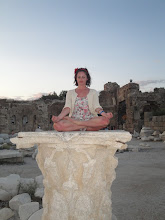“If one wants to lead a spiritual life, this very pranayama is sufficient. It will steady the way to meditation and Samadhi.”
Nadi shodhana, alternate nostril breathing, translated as ‘to cleanse/ purify the energy channel’ is the first pranayama exercise listed in the ancient yogic teachings. It balances the flow of ida and pingala, promoting equilibrium between the two energies which calms the mind, releases stress and induces a meditative state. By regulating the breath flow in the nostrils nadi shodhana balances the sympathetic and parasympathetic nervous systems.
Throughout daily life we breathe more strongly through one nostril than the other and the dominant nostril changes every 1½ hours or so, shifting the natural functioning of the brain from one side to the other. Breathing through the left nostril is connected to the right side of the brain which lends itself to creativity, calm thought processes and silence, whilst breathing through the right nostril connects to the left brain and associated logical and analytical thinking patterns alongside physical activity and verbal discussion. In yogic philosophy the sides of the brain and the correlating opposite sides of the body are represented by the god Siva,(right nostril, side of body, left brain, hot) and Shakti (left nostril, side of body, right brain, cool). Siva embodies masculinity, rationality and is represented by yang in Chinese tradition and the goddess Shakti is yin, feminine and intuition.
If people naturally breathe predominantly through the right or left nostril and the flow of prana is unbalanced this has scientifically been linked to causing a predisposition to certain health problems. For example Dr I.N. Riga’s research outlined in Kundalini Tantra has demonstrated that people who breathe mainly through the left nostril (ida) are more susceptible to paranoia and people who breathe predominantly through the right are predisposed to hypertension.
Nadi shodhana restores a balance “reintegrating the intuitive with the rational, and the feminine and with the masculine [..] allowing prana energy to vitalise your body and mind.” (p54 The Power of the Breath) and helps you to feel grounded. Nadi shodhana positively affects the respiratory process because by lengthening the breath and holding the air longer in the lungs “there is an increased potential for greater gaseous absorption, separation and elimination in the lungs” (p 93 Prana and Pranayama) which reduces the carbon dioxide level in the blood which then slows down the normal rate of breathing. Nadi shodhana is beneficial for the heart and exercises the whole cardiac system as indicated in Prana and Pranayama as follows,
“When the heart is damaged, the ratio between the systolic and diastolic periods often becomes 2:1, 3:1 or even 5:1; however, with regular practice of nadi shodhana, the correct rhythm can be restored. One can observe from the pulse that the heart rate speeds up with inspiration and slows down with expiration. Breathing with the ration 1:2 relaxes the coronary muscles without reducing the supply of oxygen to the brain and body tissues.” (p130-131 Prana and Pranayama)
Further research discussed in Prana and Pranayama concludes that nadi shodhana has profound psycho-physiological effects including improving mental processes, for example an increase in speed of completing mathematical tasks, stimulation of the cardiovascular system, balance of the autonomous nervous system and a decrease in blood pressure. I found it interesting to note that the older participants particularly benefitted from these positive effects. This was reassuring and helped me to feel confident sharing the exercise with my mum and with other more senior students in future.
Further research has substantiated my thoughts that nadi shodhana is one of the most important yogic practises and is a beneficial exercise for all. It has reiterated that we should begin with nadi shodhana before moving on to other pranayama exercises. Swami Satyananda states no other exercises are necessary, “If one wants to lead a spiritual life, this very pranayama is sufficient. It will steady the way to meditation and Samadhi.” Nadi shodhana can ultimately enable the breath to flow evenly through both nostrils transcending your awareness to higher state of meditative consciousness.

No comments:
Post a Comment